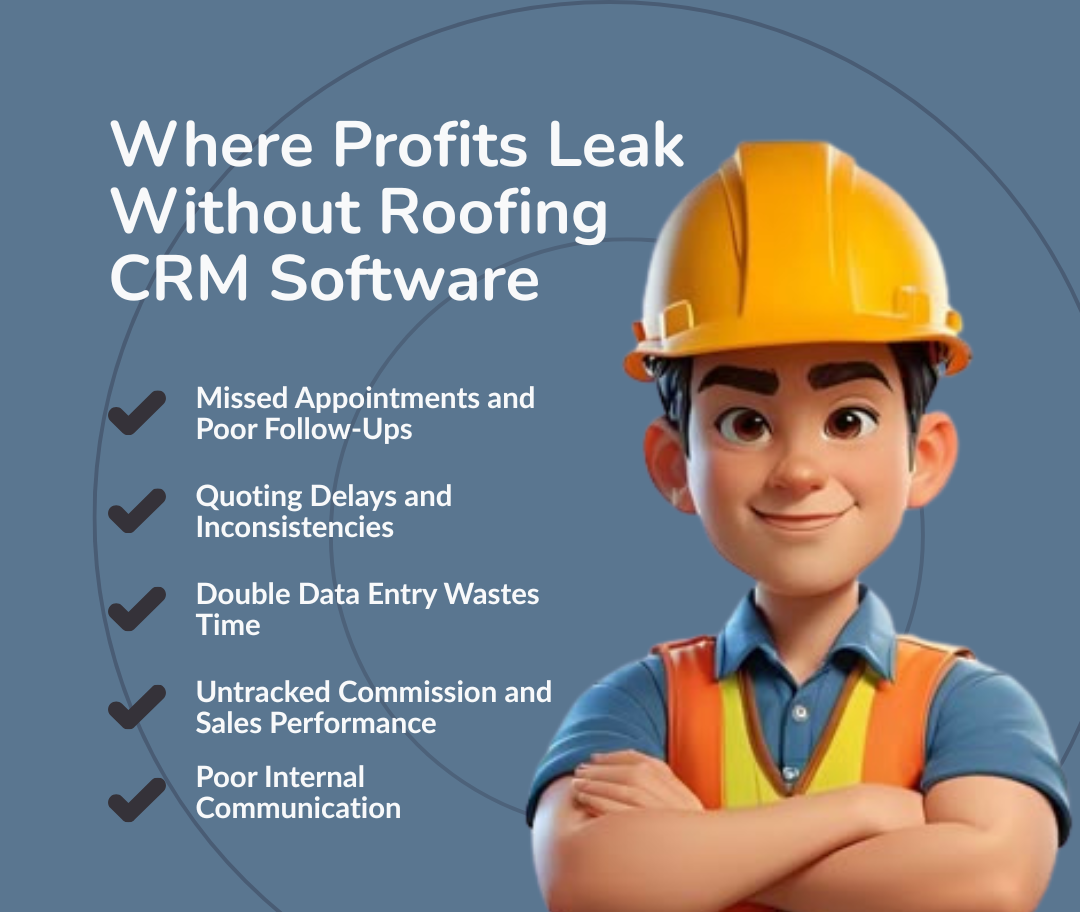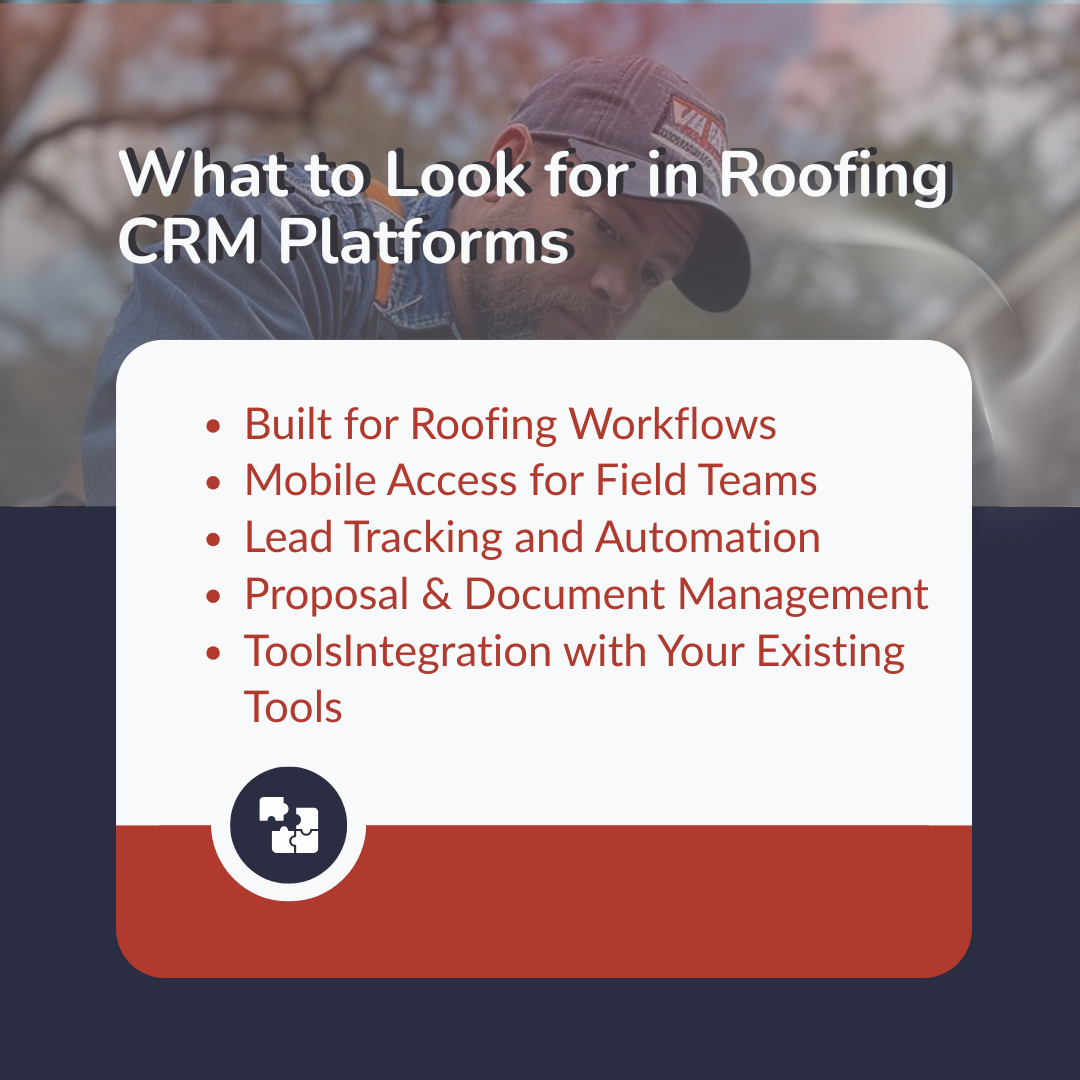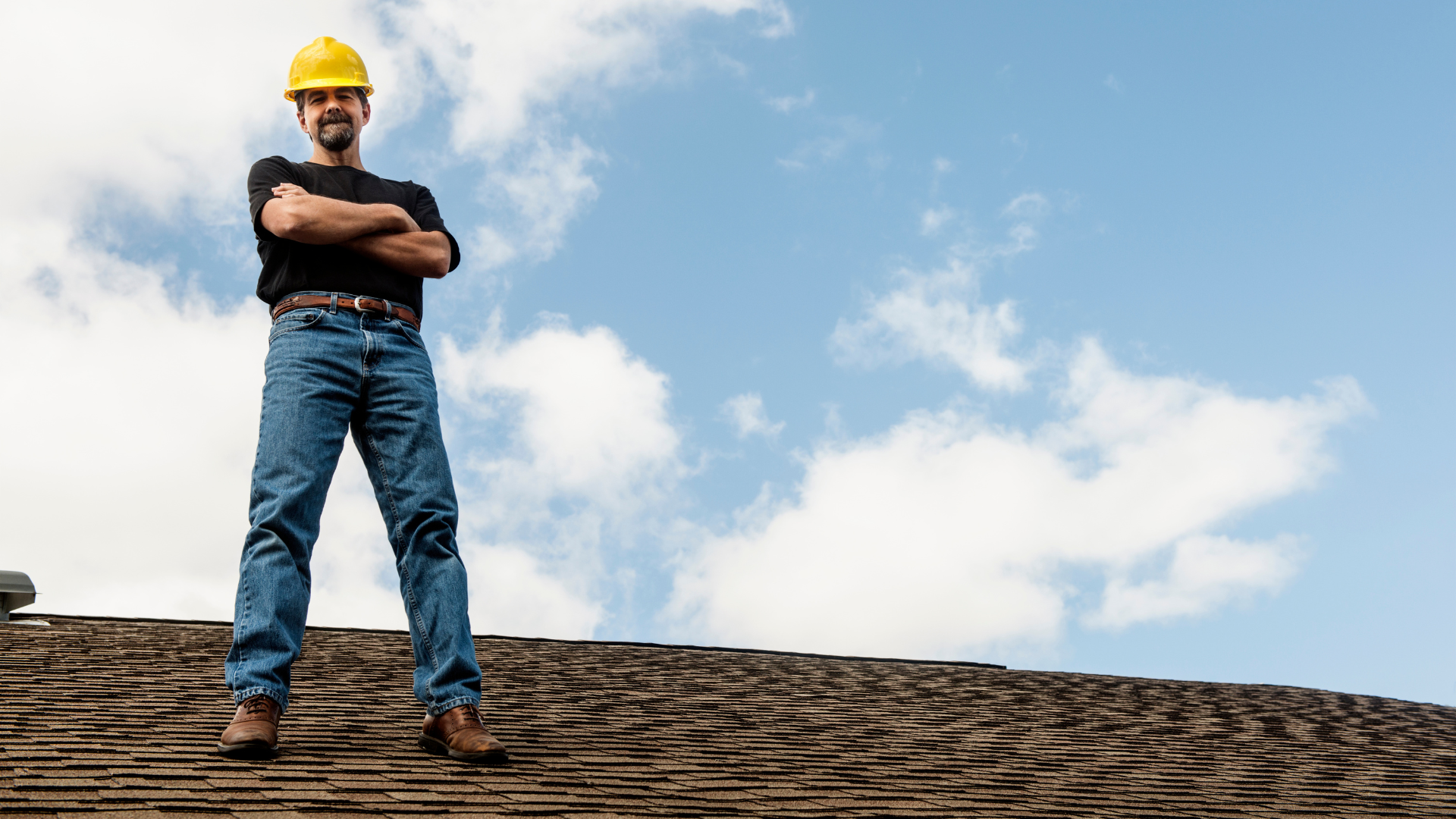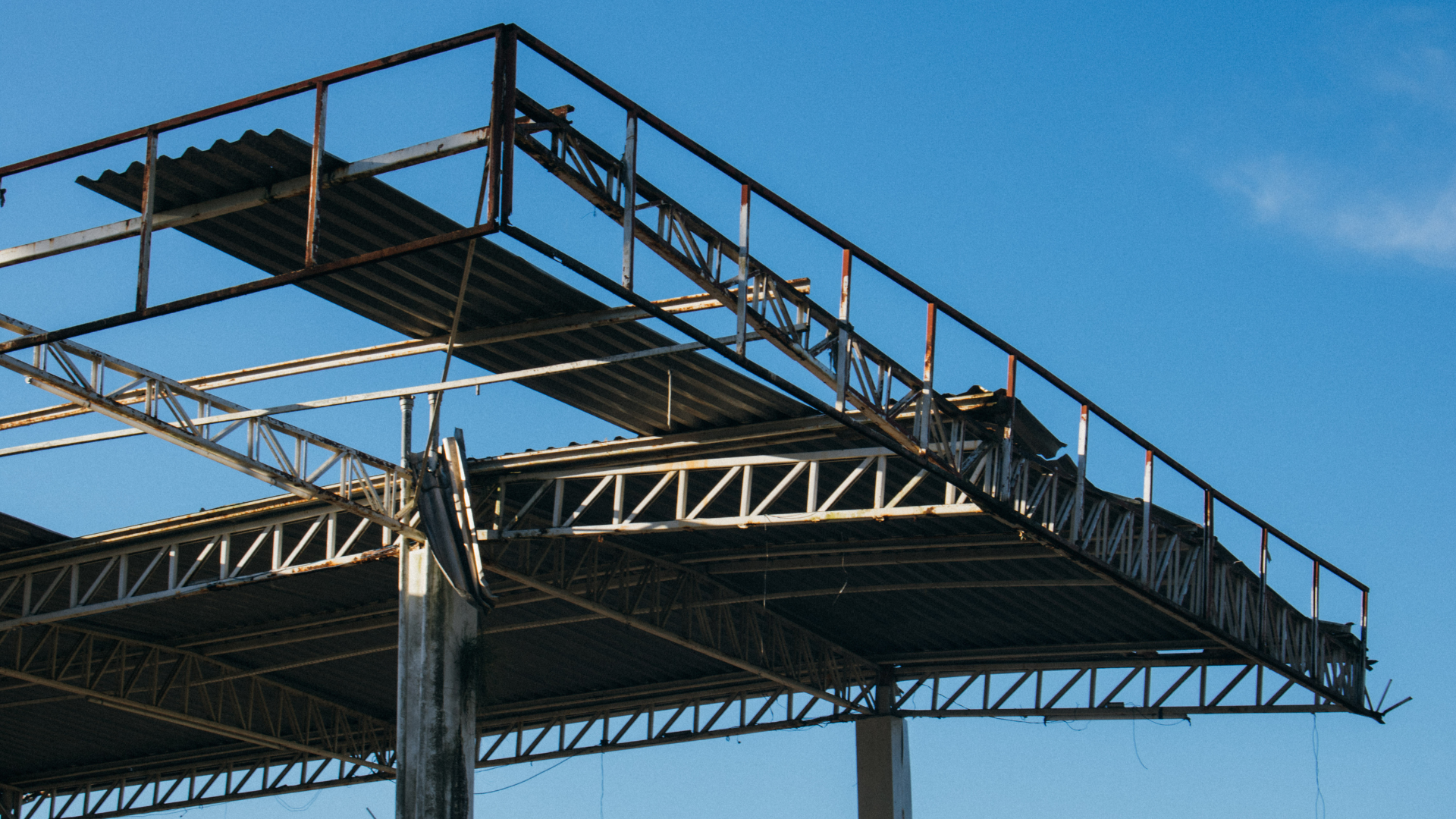June 11, 2025
Audio Overview: Listen & Learn
Picture this: You've secured a major roofing project. The lead arrived last week, yet amidst managing site visits, supplier inquiries, and pursuing payments, you overlooked the follow-up. By the time you return the call, your potential client has already engaged another contractor.
Now ask yourself: how often does this happen without you even realizing it?
In the roofing industry, lost profits frequently remain unseen. They gradually drain away due to missed appointments, neglected estimates, and chaotic customer information.
This blog is more than just a discussion about software; it aims to reveal the concealed sources of revenue loss that a Roofing CRM can effectively help you eliminate.
Key Takeaways
- Roofing companies that rely on spreadsheets and manual software are wasting time, money, and leads due to disorganization and inefficiency.
- A single, focused roofing CRM eliminates duplicate data entry, streamlines lead management, and enhances internal communication among teams.
- Without a CRM, issues like missed follow-ups, quoting mistakes, and delayed material orders can harm profitability.
- The ideal roofing CRM software supports auto-lead capture, quick proposal generation, project tracking, payment processing, and analytics dashboards.
- Rooferbase CRM provides comprehensive, one-stop tools specifically designed for roofing contractors, including scheduling, document storage, and mobile access.
Where Profits Leak Without Roofing CRM Software

Operating a roofing business without a purpose-designed CRM is the same as repairing leaks with duct tape- something comes undone eventually.
Without streamlined systems in place, roofing firms experience operational bottlenecks, lost revenue opportunities, and sagging customer satisfaction. Here's how profit is creeping away:
1. Missed Appointments and Poor Follow-Ups
When leads are not followed up quickly, they go cold. Relying on manual notes, spreadsheets, or memory to monitor calls and appointments nearly confirms that something will fall through the cracks.
Every missed appointment represents a potential job lost, and in a competitive environment, homeowners will often choose the first person who responds.
Loss Impact: Missed follow-ups = fewer scheduled jobs = decreased revenue.
2. Quoting Delays and Inconsistencies
Creating estimates manually or with outdated systems slows down your sales process. Even worse, quoting errors can lead to underbidding or disputes with clients.
If your sales team is sending out proposals days after a site visit, you’re already behind roofing companies using fast, digital tools.
Loss Impact: Lost deals due to delays, incorrect pricing, and reduced client trust.
3. Double Data Entry Wastes Time
Entering the same information into multiple systems, such as the lead system, the scheduling system, and a separate billing system, wastes hours each week.
And it raises the risk of errors, from misaddressed payments to incorrect charges.
Loss Impact: Decreased productivity, administrative costs, and billing errors impacting your bottom line.
4. Untracked Commission and Sales Performance
Without CRM capabilities such as commission tracking or sales dashboards, it's challenging to reward your team or identify who is converting leads into jobs.
You might be overpaying low performers or missing opportunities to reward and retain top sellers.
Loss Impact: Ineffective sales incentives and under-leveraged team potential.
5. Poor Internal Communication
Without a centralized forum for communication, important job announcements often get lost among group messages, calls, or isolated apps.
Field staff sometimes miss out on the latest information, administrative personnel are searching for lost documents, and clients remain unaware.
Loss Impact: Delayed progress of work, redundant efforts, and expensive misunderstandings between your staff and customers.
So, what's the solution? Well, you just need a robust Roofing CRM!
Why More Roofing Companies Are Switching to CRM Software
The roofing industry is evolving fast, and roofing companies that want to stay competitive in 2025 are embracing technology to stay ahead. One of the most important shifts?
Moving away from outdated manual processes and toward roofing CRM software that centralizes every aspect of the business. A roofing CRM is more than just an app; it is the business backbone of top-performing roofing firms.
Here’s why more roofing contractors are making the switch:
1. Lead Management is Out of Control Without a CRM
Roofing companies today typically handle leads from multiple sources, including the web, phone calls, referrals, door-to-door sales, and more. Without a system to track and follow up on these leads, it's easy for them to fall through the cracks.
A roofing CRM like Rooferbase automates the process of capturing leads, consolidating contact information, and ensures that no opportunity is missed.
That translates to better-qualified leads and more booked jobs!
2. Manual Sales Processes Are Slowing Teams Down
From proposal sending to follow-up with prospects, manual sales processes introduce delays and opportunities for human error.
Roofing CRM solutions empower your salespeople to create concise, professional proposals and automate follow-ups, enabling you to close deals more quickly and secure more contracts.
3. Project Management Needs a Central Hub
Handling roofing projects involves several key steps: estimating, material ordering, crew scheduling, capturing job site photographs, and billing.
CRM applications serve as a single project management software, keeping your whole team on the same page, regardless of their location. It reduces internal communication problems and avoids duplicate data entry.
4. Homeowners Expect a Seamless Experience
Today's customers are seeking professionalism, timely updates, and seamless digital interaction. Roofing CRMs allow you to text, set appointments, and post job updates
from a single platform.
That enhanced customer experience translates into improved reviews, increased referrals, and repeat business.
5. Data-Driven Decisions Mean Faster Growth
With built-in analytics dashboards, CRMs provide powerful insights into sales performance, team productivity, and cash flow.
Roofing businesses can utilize this data to forecast revenue, track return on investment (ROI), and streamline their operations. The result? Smarter decisions and more predictable growth.
What the Right Roofing CRM Can Do for You
A robust roofing CRM isn't a nice-to-have; it's what drives you to complete more jobs with less stress and greater profit.
From generating leads to collecting the final payment, the optimal CRM bridges all aspects of your roofing business into one smooth, streamlined system.
1. Auto Lead Capture and Follow-Up
The top roofing CRM solutions capture leads from your website, phone calls, forms, and even social media, and then immediately assign them to your sales reps.
Automated reminders, sent via text message, email, or call, ensure every lead is saved from falling through the cracks.
Profit Impact: Improved lead-to-sale conversion rate, reduced time spent on manual data entry, and fewer lost opportunities.
2. Fast, Professional Proposals and Estimates
With preloaded templates, real-time pricing, and aerial measurements, your salespeople can issue branded, precise proposals in minutes after a site visit. Some roofing CRMs also offer digital signature capabilities for quick approvals.
Profit Impact: Win more jobs by quoting faster and more precisely than the competition; eliminate errors that eat into profits.
3. Job Scheduling and Calendar Integration
Keep your roofing crew on the same page with intelligent scheduling software that integrates with Google Calendar or Outlook. Schedule crews, track availability, and re-timing without playing phone tag and spreadsheet roulette.
Profit Impact: Reduced delays, improved resource utilization, and more roofing projects finished on time.
Discover how Roofing CRM software can enhance customer retention.
What to Look for in Roofing CRM Platforms

When shopping around for roofing CRM solutions, don't accept a generic solution. Find one that offers:
1. Built for Roofing Workflows
You require a CRM like Rooferbase, explicitly designed for roofing companies, not a broad tool intended for all industries.
Seek out systems that support roofing sales cycles, aerial measurements, material orders, inspections, and job photos. Custom fields and roofing-specific templates are a huge plus.
2. Mobile Access for Field Teams
Your sales reps, project managers, and crew leads are rarely sitting at desks.
A roofing CRM should offer a powerful mobile app that works seamlessly in the field—on rooftops, at job sites, and during homeowner consultations.
3. Lead Tracking and Automation
From door-to-door canvassing to digital ads, leads come in fast, and they need to be acted on even faster.
A great CRM automates lead capture, assigns reps, and sends instant follow-up emails or texts.
4. Proposal & Document Management Tools
Speed and professionalism are important in roofing sales.
Your CRM must enable your team to create and send electronic estimates in minutes, save contracts, and manage signatures without requiring a change in platforms.
5. Integration with Your Existing Tools
Your roofing CRM must be a central hub, not a silo.
Great CRMs integrate seamlessly with your calendar, email, accounting programs, ordering systems, and beyond, eliminating duplicate data entry and enhancing team collaboration.
How to Make the Switch (Without the Headache)
Changing to a new roofing CRM might feel daunting, but it doesn't have to be. Here's an easy adoption plan:
1. Assess your existing system
Take a close look at what isn't working before you make any changes.
- Are you losing leads because of missed follow-ups?
- Are double entries clogging up your admin team?
- Are job site updates taking longer because of communication breakdowns?
Identify bottlenecks in your scheduling, material ordering, internal communication, or sales process. Then you can narrow down CRM functionality to address the most
pressing problems.
2. Compare various features between 2–3 roofing CRMs
Don't jump at the first option you come across. Compare roofing CRM solutions side by side and look at those designed specifically for roofing contractors.
Look for key features such as mobile access, aerial measurements, proposal tools, seamless integration with your accounting software, and straightforward onboarding.
Consider scalability if you have multiple locations or anticipate expanding your roofing business.
3. Begin with one feature: Lead management or scheduling
Rather than attempting to roll out everything at once, start with a single feature of high impact, such as lead management or project scheduling.
This prevents overwhelming your roof crew and sets the stage for confidence as they see the tool enhance their day-to-day workflow.
You can then add other tools, such as proposal generation, document storage, job tracking, or commission tracking, over time.
4. Train your team incrementally, gather feedback, and modify workflows
Segment training into manageable chunks specific to team roles.
Your salespeople should become proficient in lead tracking and electronic proposals, while your project managers concentrate on job scheduling, material orders, and status updates.
Invite feedback during initial usage and be willing to adjust settings, workflows, or integrations based on feedback from your team. Adoption increases when the CRM serves your team, not against them.
5. Track ROI: Monitor time saved, revenue gained, and leads closed
Use your CRM's analytics dashboard to gauge success. Monitor KPIs such as:
- Time saved per job
- Conversion rate from new leads
- Revenue per rep
- Reduction in double data entry or phone calls
This real-time information demonstrates the return on investment (ROI) of your CRM investment and justifies future upgrades or corporate-wide adoption.
Discover the Key Advantages of Adopting a Roofing CRM System
Why Rooferbase is the Best Roofing CRM for Your Company
Rooferbase is a great CRM designed for roofing contractors who want powerful tools, fewer headaches, and more revenue.
With Rooferbase, you get:
- Smart lead management
- Fast, accurate proposals using aerial measurements
- Integrated project management and job scheduling
- One location for documents, messages, and updates
- Automated communication via email and SMS
- Popular integrations and tools that eliminate double entry
- Built-in analytics dashboards for real-time insights
Whether you're managing 10 or 100 roofing projects, Rooferbase helps your sales team, crews, and managers work smarter, not harder.
Final Thoughts:
Internal communication is more important than you realize! From the initial proposal to the final payment, an effective roofing CRM ensures your team stays organized, efficient, and focused on growth.
Each day without a roofing CRM is another day you risk losing revenue to slow proposals, lost leads, and inefficient project management.
Roofing apps like Rooferbase provide you with all the tools you need in one place to grow your roofing business, increase efficiency, and acquire more contractors more
quickly.
About Rooferbase
Ready to plug the leaks and begin growing?
Sign up for Rooferbase now!
FAQ's
1. How can a roofing CRM reduce overhead costs across multiple locations?
A robust roofing CRM centralizes scheduling, team coordination, and reporting, enabling efficient management of multiple locations without requiring duplicate staff. Real-time data access removes communication delays, while standardized workflows cut administrative overhead and costly errors.
2. What CRM features directly improve the efficiency of the roofing sales process?
Key features, including automated lead routing, instant proposal generation, integrated aerial measurements, and follow-up reminders, enable your sales team to respond more quickly and close more jobs. This reduces bottlenecks and keeps prospects from slipping through the cracks.
3. Can a roofing CRM help track job profitability in real-time?
Yes. Advanced CRMs offer job-cost tracking, labor and material inputs, and performance analytics dashboards. You can monitor margins per project, adjust in-progress workflows, and catch cost overruns early, leading to smarter financial decisions on every roofing job.






